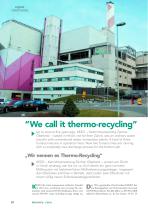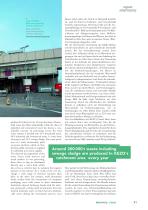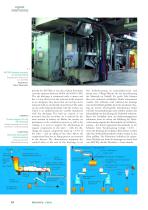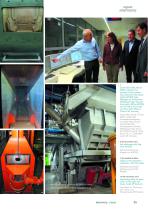 Website:
AViTEQ Vibrationstechnik GmbH
Website:
AViTEQ Vibrationstechnik GmbH
Catalog excerpts

metal recovery ►Up to around five years ago, KEZO - Kehrichtverwertung Zurcher Oberland - based in Hinwil, not far from Zurich, was an ordinary waste recycler with conventional waste incineration plants. A total of three furnace lines are in operation here. Now two furnace lines are running with a completely new discharge process for the bottom ash. ►KEZO - Kehrichtverwertung Zurcher Oberland - unweit von Zurich in Hinwil ansassig, war bis vor ca. funf Jahren ein ganz normaler Mullrecycler mit herkommlichen Mullverbrennungsanlagen. Insgesamt drei Ofenlinien sind hier in Betrieb. Jetzt laufen zwei Ofenlinien mit einem vollig neuen Schlackeaustragsverfahren. KEZO, the waste management authority founded ^^er 1961 gegriindete Zweckverband KEZO hat in 1961, has a catchment area covering 38 com- €va Einzugsgebiet von 38 Gemeinden mit rund munities with around 322 000 inhabitants. Every year 322 000 Einwohnern. Pro Jahr fallen ca. 200 0001 Mull around 200 0001 waste including sewage sludge are inklusive Klarschlamm an. In den letzten 10 bis 15
Open the catalog to page 1
metal recovery Zurcher Oberland Zurcher Oberland Photo/Foto: Marvin Klostermeier produced. In the last 10 to 15 years, the share of house- hold waste has fallen substantially while the share of industrial and commercial waste has shown a con- siderable increase. In percentage terms, the total waste volume is divided into 41 % household waste, 49% industrial and commercial waste (+ waste from Germany) and 10% sewage sludge. The main prod- ucts of a waste incineration plant are power and heat, which are then fed into public networks or supplied to individual users (heat supply). waste leaves...
Open the catalog to page 2
Waste handling at KEZO Marvin Klostermeier with water to form a cementitious paste, from which the fine and precious metals contained can only be recovered by means of washing and drying process- es, incurring considerable extra cost and energy con- sumption. Fig. 3a left shows ashes from a wet dis- charge process. The quenching of the slag also leads to water vapour forming in the combustion cham- ber, which can result in slagging inside the furnace. In addition, with a water content of around 20%, a corresponding large quantity of slag is obtained. Managing Director at KEZO, Daniel Boni,...
Open the catalog to page 3
metal recovery for example, from aluminium, tin, zinc, lead, silver and even gold. Recycling these metal beads can yield a valuable resource whereas landfilling them causes environmental problems. The metals have to be removed for further use or landfilling, as otherwise this can lead to a heavy metal contamination of the envi- ronment. Despite process optimization, KEZO could not get the moisture content of the wet discharged ashes below 16%. For this reason, they started thinking about dry discharge of the ashes. The key advantage of dry discharge is that the ashes can be treated like...
Open the catalog to page 4
metal recovery AViTEQ vibrating conveyor Eingehauste Vibrorinne Marvin KEostermeier trockenen Schlackeaustrag metal processing priority for AViTEQ, as one day of plant downtime costs the operator between 50 000 and 60 000 CHE The ash discharge is monitored with a camera and has a 2-way diverter for the removal of the material in an emergency. Any pieces that are too big can be removed with an electrically moved hood.The ashes are air-cooled during discharge with the tertiary air, which is an additional process variable introduced with dry discharge. The total air content is not increased,...
Open the catalog to page 5
metal recovery Daniel Boni (left), MD at process control system - also pictured Heinz Staub (right) AViTEQ Sales Wolfgang Finger (second from right), MD at AViTEQ, ond from left), Editor-in Daniel Boni (links), GF der mit dabei Heinz Staub (rechts) AViTEQ- Vertriebsleiter Schweiz, 8 {left above/links oben) Ash discharge with flap from AViTEQ 9 (left middle/links Mitte) Eddy current separator - 10 (left below/links unten) Separating table for sepa- heavy metal NF fractions
Open the catalog to page 6
metal recovery AViTEQ screen that screens off the oversize > 5 mm. The ashes can then be processed like a conventional bulk solid. After fine-separation, the micro-ashes 0-0.7 mm are screened off and the remaining fine ashes (0.7 to 5.0 mm) undergo NF separation in eddy current separators. On separating tables, the NF metal fractions are separated into heavy and light metals (aluminium). The non-ferrous metal fraction consists of around 70 % aluminium, 15 % copper, and 15 % other metals such as lead, bronze, zinc, tin, sil- ver and gold. The separating efficiency exceeds 95%; the metal...
Open the catalog to page 7All AViTEQ Vibrationstechnik GmbH catalogs and technical brochures
-
Compact feeders
9 Pages
-
Unbalanced motors
20 Pages
-
Loss-in-Weight System
2 Pages
-
Weiteq WBF belt weigh feeder
4 Pages
-
Magnetic vibrators
13 Pages
-
Conveying equipment
16 Pages
-
Screening technology
3 Pages
-
Image brochure (EN)
9 Pages
-
Unbalanced motors UV
11 Pages
-
Overview vibrating screen
4 Pages
-
Vibration conveyors
12 Pages
-
VIBTRONIC® controllers SA(E)
66 Pages
-
VIBTRONIC® controllers SC(E)
44 Pages
-
VIBTRONIC® controllers SFA 06
18 Pages
-
Small conveyors units KF, ATEX
38 Pages
-
Electronic controllers SC(E)
2 Pages
-
Small conveyor units KF
13 Pages
-
Magnetic vibrators MV
11 Pages





















